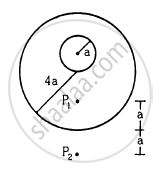Advertisements
Advertisements
प्रश्न
Particles of masses 2M, m and M are respectively at points A, B and C with AB = ½ (BC). m is much-much smaller than M and at time t = 0, they are all at rest (Figure). At subsequent times before any collision takes place ______.

पर्याय
m will remain at rest.
m will move towards M.
m will move towards 2M.
m will have oscillatory motion.
उत्तर
Particles of masses 2M, m and M are respectively at points A, B and C with AB = ½ (BC). m is much-much smaller than M and at time t = 0, they are all at rest (Figure). At subsequent times before any collision takes place m will move towards 2M..
Explanation:
The particle m at B will move towards A with the greater force, due to particle 2M at A.
Force on m at B due to 2M at A is
`F_(BA) = (G(m xx 2M))/(AB)^2` towards `BA`
Force on mass m at B due to mass M at C is
`F_(BC) = (G(M xx M))/(BC)^2` towards `BC`
Therefore, the resultant force on mass m at B due to masses M and 2M is
`F_"net" = F_(BA) - F_(BC)` .....(Because FBA and FBC are acting in opposite directions)
`F_"net" = (2GMm)/(AB)^2 - (GMm)/(BC)^2`
As `(BC) = 2AB`
⇒ `F_"net" = (2GMm)/(AB)^2 - (GMm)/(2AB)^2`
= `(2GMm)/(AB)^2 - (GMm)/(4(AB)^2`
= `(7GMm)/(4(AB)^2` (along BA)
Hence, m will move towards BA (i.e., 2M).
APPEARS IN
संबंधित प्रश्न
Answer the following:
You can shield a charge from electrical forces by putting it inside a hollow conductor. Can you shield a body from the gravitational influence of nearby matter by putting it inside a hollow sphere or by some other means?
Can two particles be in equilibrium under the action of their mutual gravitational force? Can three particles be? Can one of the three particles be?
A uniform metal sphere of radius a and mass M is surrounded by a thin uniform spherical shell of equal mass and radius 4a (In the following figure). The centre of the shell falls on the surface of the inner sphere. Find the gravitational field at the points P1 and P2 shown in the figure.

At what height above the earth's surface would the value of acceleration due to gravity be half of what it is on the surface? Take the radius of earth to be R.
The distance-time values for an object moving along straight line are given below:
| Time (s) | Distance (m) |
| 0 | 0 |
| 1 | 1 |
| 2 | 8 |
| 3 | 27 |
Answer the following question.
State Newton’s law of gravitation and express it in vector form.
Different points in earth are at slightly different distances from the sun and hence experience different forces due to gravitation. For a rigid body, we know that if various forces act at various points in it, the resultant motion is as if a net force acts on the c.m. (centre of mass) causing translation and a net torque at the c.m. causing rotation around an axis through the c.m. For the earth-sun system (approximating the earth as a uniform density sphere).
If the law of gravitation, instead of being inverse-square law, becomes an inverse-cube law- ______.
- planets will not have elliptic orbits.
- circular orbits of planets is not possible.
- projectile motion of a stone thrown by hand on the surface of the earth will be approximately parabolic.
- there will be no gravitational force inside a spherical shell of uniform density.
The gravitational force between a hollow spherical shell (of radius R and uniform density) and a point mass is F. Show the nature of F vs r graph where r is the distance of the point from the centre of the hollow spherical shell of uniform density.
Give scientific reasons for the following:
Newton's gravitational law is the universal law of gravitation.
